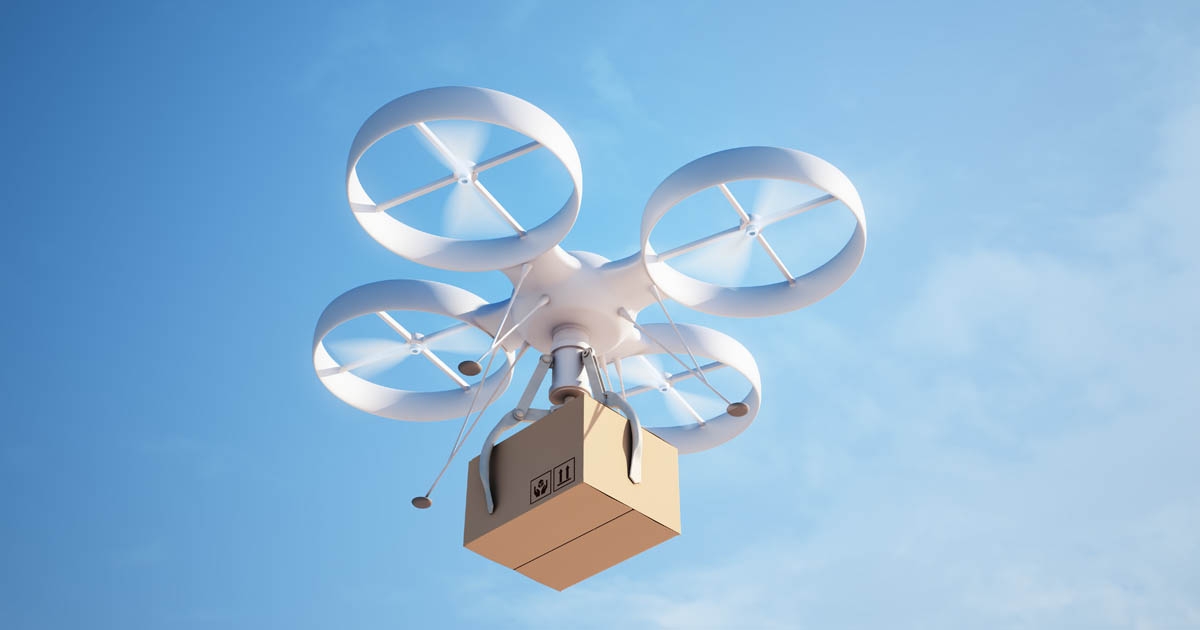The first delivery drones are allowed to be used on a larger scale in the USA. Reason enough for //next columnist Don Dahlmann to ask whether drones will steer the future of logistics in completely new directions.

The logistics industry is one of the most important sectors of the economy. The global trade in goods is one thing, the delivery of goods to private customers is another. Especially there, there have been big changes in recent years. A few years ago, parcels took a few days to reach the recipient. The delivery was usually not made to the front door either. Instead, you got a parcel card telling you that you could pick up your ordered goods at the post office. Today, things are different. In big cities, orders are sometimes delivered within a few hours.
In the countryside, however, things look a little different. The delivery infrastructure is thinner here, so deliveries can take a while. At least until now. Because in various countries, the logistics industry is now also using a completely new technology. Drones are supposed to simply drop off the parcels in the front garden.
In the USA, this has already happened. The Federal Aviation Administration in the USA, the highest aviation authority, has in principle allowed the company Amazon Prime Air to operate as an aviation company. Amazon will soon be able to start regular parcel deliveries with its drones and thus conquer completely new markets.
For logistics companies, drones are not only a technical challenge. Above all, they are an opportunity to conquer new markets and dramatically reduce delivery costs. These costs increase the more remote the customers are from the companies' central warehouses. Here, it is mainly the costs for drivers and vehicles that companies would like to reduce. Drones are cheaper, can be operated around the clock and also deliver to areas where delivery has been difficult so far.
Personnel costs play an enormously large role in logistics and of course delivery services want to reduce these costs as much as possible. In the cities, delivery by messenger will definitely be maintained, but where individual parcels have to be delivered over long distances, the costs naturally rise considerably. Autonomous drones are then a promising solution for the industry.
A good example of how well and cheaply drones can work is the US start-up Zipline. The company has been delivering medicines, blood reserves and vaccines in the African countries of Rwanda and Ghana since 2016. Zipline is already responsible for 65 per cent of all deliveries of blood reserves outside the capital of Rwanda. Urgently needed supplies can be ordered via WhatsApp and, depending on the distance, can be delivered within a few hours.
But what about in the industrialised countries? Deliveries by drone are rather not possible in the inner city. But the suburbs are exactly what e-commerce retailers are worried about because of delivery costs. So will parcels soon be dropped in the front garden? It won't be that simple. Drone traffic is heavily regulated, especially in Germany and metropolitan areas. German security concerns stand in the way of a quick solution here.
DHL, however, has found a solution to at least solve the delivery problem in the suburbs. Instead of dropping the parcels in the garden, a drone in China delivers them to a special station in the neighbourhood. Customers can then conveniently pick up their parcels when it suits them. Something like this can also be imagined in Europe, even if it will certainly not work everywhere.
The cost savings are enormous, according to DHL. Up to 80 percent of the total delivery costs can be saved this way. In addition, there are the reduced emissions, which promises high savings potential for a delivery company. This is because the industry is asked to pay if they exceed the emission limits permitted for them. But of course, the reduction of emissions also has positive effects on climate change. So drones could also provide a drastic improvement here.
The next few years will therefore be very exciting in the logistics market. Thanks to drone deliveries, the e-commerce market can also spread to countries that have so far been cut off from the offerings. In addition, there is the large market of deliveries in the medical sector, which are state-subsidised, especially in emerging countries. So the package will indeed come from the air in some areas as early as the next few years.
Text: Don Dahlmann
Are air taxis really the solution to traffic problems?
Most popular